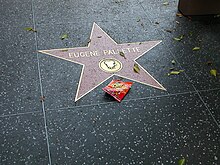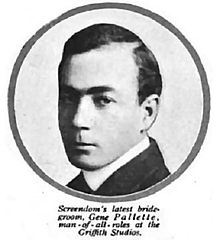Eugene Pallette
Eugene Pallette (born July 8, 1889 in Winfield , Kansas , † September 3, 1954 in Los Angeles , California ) was an American actor who starred in over 250 film productions between 1915 and 1946.
Life

Born in Kansas in 1889 to a couple of actors, Eugene Pallette came into contact with show business at a young age. When his parents went on tour, he would go from town to town with them until he eventually attended a military academy in Indiana to complete his schooling. He also worked as a jockey . However, like his parents, he wanted to be an actor, which is why he moved to Los Angeles . From 1913 he worked as a stuntman in film . A year later he received leading roles as a villain, but also as a romantic hero alongside silent movie stars like Dorothy Gish . 1915 and 1916 he worked in D. W. Griffiths cinematic milestones The Birth of a Nation ( The Birth of a Nation , in a small role as a wounded soldier) and Intolerance (as Prosper Latour in the "Renaissance episode") with.
With the entry of the United States into the First World War , Pallette had to interrupt his career for two years in 1916 in order to do his military service in an air corps. Since he gained more and more weight during and after this time, he came from 1919 almost only for supporting roles, including that of Aramis in the Dumas film The Three Musketeers ( The Three Musketeers , 1921) with Douglas Fairbanks . At times he turned away from acting to make a fortune in Texas doing oil business. However, after a bad investment that cost him all of his profits, he returned to the big screen. In 1927 and 1928 he starred in various short film comedies by the Roach studios alongside Laurel and Hardy , Mabel Normand , Charley Chase , Max Davidson and the little rascals .
With the emergence of the sound film at the end of the 1920s, Pallette's deep “frog voice” was finally used, which, in addition to his now corpulent stature and his acting talent, established him as an unmistakable character actor. The first sound film in which he participated was Lights of New York in 1928 , the first continuous sound film ever. His second sound film was The Canary Murder Case (1929), the debut of the Philo Vance series, in which he was responsible for the comic relief between 1929 and 1934 as the savvy sergeant Ernest Heath . In 1936, he played the down-to-earth patriarch of an eccentric family in the comedy film Mein Mann Godfrey, alongside William Powell and Carole Lombard . He had similar roles as the wealthy head of the family in other comedies such as Preston Sturges ' Die Falschspielerin (1941) and Ernst Lubitsch's A Heavenly Sinner (1943). He had one of his most famous appearances as Brother Tuck in Robin Hood, King of the Vagabonds ( The Adventures of Robin Hood , 1938) at the side of Errol Flynn and Olivia de Havilland . Two years later, Pallette played another strong cleric alongside Tyrone Power in In the Sign of Zorro (1940). Usually used in sympathetic and comedic roles, he also occasionally played dodgy characters, for example as the dubious political advisor in Frank Capra's Mr. Smith Goes to Washington (1939).
In 1944 he was cast as the father of Jeanne Crain in In the Meantime, Darling . Allegedly, Pallette is said to have refused to sit next to the black actor Clarence Muse on the film set. The director Otto Preminger later stated that Pallette was a staunch supporter of Hitler and was certain that Germany would win the Second World War. After this scandal with Muse, Pallette was dismissed from studio boss Darryl F. Zanuck and played the remaining two years of his career exclusively in B-films. After more than 250 films, he retired to his ranch in Oregon in 1946 , where he built a bunker for fear of a nuclear attack by the Soviet Union . However, two years later he returned to Los Angeles.
His first wife was the actress Phyllis Gordon. From 1932 until his death he was married to Marjorie Cagnacci for the second time. He died in 1954 at the age of 65 in his apartment in Los Angeles of throat cancer . His bones were cremated in the crematorium of Valhalla Memorial Park in Hollywood and the ashes were then buried in Green Lawn Cemetery in Grenola , Kansas , in an unmarked grave near his parents' tomb. For his services to American films, Eugene Pallette received a star on the Hollywood Walk of Fame (6702 Hollywood Boulevard).
Filmography (selection)
- 1915: The Birth of a Nation ( The Birth of a Nation )
- 1916 intolerance ( Intolerance )
- 1918: Tarzan of the Apes ( Tarzan of the Apes )
- 1921: The Three Musketeers ( The Three Musketeers )
- 1923: Among the Wolves of Alaska ( North of Hudson Bay )
- 1923: The Ten Commandments ( The Ten Commandments )
- 1927: Fluttering Hearts
- 1927: Sugar Daddies
- 1927: The Battle of the Century ( The Battle of the Century )
- 1927: The Second Hundred Years
- 1928: Lights of New York
- 1929: The man from Virginia (The Virginian)
- 1929: The Canary Murder Case
- 1929: The Love Parade (The Love Parade)
- 1930: Paramount Parade (Paramount on Parade)
- 1931: Hollywood jewel theft (The Stolen Jools)
- 1931: Girls About Town
- 1932: Shanghai Express (Shanghai Express)
- 1932: Dancers in the Dark
- 1933: The Kennel Murder Case
- 1935: City on the border (Bordertown)
- 1935: All the King's Horses
- 1935: Full steam ahead (Steamboat Round the Bend)
- 1935: The Ghost Goes West (The Ghost Goes West)
- 1936: My husband Godfrey (My Man Godfrey)
- 1936: Sunshine ( Stowaway )
- 1937: Topper - The blonde ghost ( Topper )
- 1937: 100 men and a girl ( One Hundred Men and a Girl )
- 1938: Robin Hood, King of the Vagabonds ( The Adventures of Robin Hood )
- 1938: Millionaire gone astray ( There Goes My Heart )
- 1939: Mr. Smith Goes to Washington ( Mr. Smith Goes to Washington )
- 1939: First Love
- 1940: The young Edison ( Young Tom Edison )
- 1940: The Mark of Zorro ( The Mark of Zorro )
- 1941: The Cardsharp ( The Lady Eve )
- 1941: The bride came cash on delivery ( The Bride Came COD )
- 1941: World premiere ( World Premiere )
- 1941: Unfinished Business
- 1941: In the Swamp ( Swamp Water )
- 1941: consultation for Love ( Appointment for Love )
- 1942: Subject: Der Mann ( The Male Animal )
- 1942: Six Fates ( Tales of Manhattan )
- 1942: Blazing Flames ( The Forest Rangers )
- 1942: Silver Queen
- 1943: Heaven Can Wait ( Heaven Can Wait )
- 1943: The Sheriff of Kansas ( The Kansan )
- 1943: The Gang's All Here
- 1944: Pin Up Girl
- 1944: Step Lively
- 1944: Sensations for Millions ( Sensations of 1945 )
- 1946: The Bandit of Sacramento ( In Old Sacramento )
- 1946: The tire of death ( Suspense )
Web links
- Eugene Pallette in the Internet Movie Database (English)
- Pictures by Eugene Pallette In: Virtual History
- Eugene Pallette on All Movie Guide
- Eugene Pallette in the database of Find a Grave (English)
Individual evidence
- ^ Eugene Palette at Allmovie
- ↑ Eugene Pallette at Find A Grave
- ↑ Fujiwara, Chris, The World and Its Double: The Life and Work of Otto Preminger . New York: Macmillan Publishers 2009. ISBN 0-86547-995-X , p. 34
- ↑ Lindsay Barnett: Eugene Pallette . In: Los Angeles Times , June 8, 2010.
| personal data | |
|---|---|
| SURNAME | Pallette, Eugene |
| BRIEF DESCRIPTION | American film actor |
| DATE OF BIRTH | July 8, 1889 |
| PLACE OF BIRTH | Winfield , Kansas |
| DATE OF DEATH | 3rd September 1954 |
| Place of death | Los Angeles , California |
